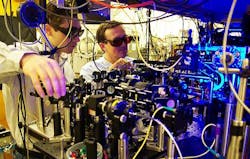Rydberg technique from Georgia Tech rapidly and efficiently creates single photons
Atlanta, GA--Georgia Institute of Technology (Georgia Tech) physicists have developed a new way to rapidly and efficiently create single photons for potential use in optical quantum information processing as well as the study of dynamics and disorder in certain physical systems that uses lasers to excite just one atom from a cloud of ultra-cold rubidium gas. The technique takes advantage of the unique properties of atoms that have one or more electrons excited to a condition of near-ionization known as the Rydberg state. Atoms in this highly excited state—with a principal quantum number greater than 70—have exaggerated electromagnetic properties and interact strongly with one another, allowing one Rydberg atom to block the formation of additional excited atoms within an area of 10 to 20 microns and be converted to a single photon.
The new technique was reported April 19 in Science Express. "We are able to convert Rydberg excitations to single photons with very substantial efficiency, which allows us to prepare the state we want every time," explained Alex Kuzmich, a professor in the School of Physics at the Georgia Institute of Technology. "This new system offers a fertile area for investigating entangled states of atoms, spin waves and photons. We hope this will be a first step toward doing a lot more with this system."
Kuzmich and co-author Yaroslav Dudin, a graduate research assistant, have been studying quantum information systems that rely on mapping information from atoms onto entangled pairs of photons. But the Raman scattering technique they have been using to create the photons was inefficient and unable to provide the number of entangled photons needed for complex systems.
"This new photon source is about a thousand times faster than existing systems," Dudin said. "The numbers are very good for our first experimental implementation."
To create a Rydberg atom, the researchers used lasers to illuminate a dense ensemble of several hundred rubidium 87 atoms that had been laser-cooled and confined in an optical lattice. The illumination boosted a single atom from the entire cloud into the Rydberg state. Atoms excited to the Rydberg state strongly interact with other Rydberg atoms, and under suitable conditions, modify the atomic level energies and prevent more than one atom from being transferred into this state—a phenomenon known as the Rydberg blockade.
Once a highly excited atom was created, the researchers used an additional laser field to convert the excitation into a quantum light field that has the same statistical properties as the excitation. Because the field was produced by a single Rydberg atom, it contained just one photon, which can be used in a variety of protocols.
The single-photon work complements research being done in the Kuzmich lab on long-lived quantum memories. A new Air Force Office of Scientific Research Multidisciplinary University Research Initiative (MURI) was recently awarded to a consortium of seven U.S. universities that will work together to determine the best approach for generating quantum memories based on interaction between light and matter. Georgia Tech leads the MURI.
"With this new work, we have demonstrated a new, deterministic source of single photons," Kuzmich said. "In its first experimental realization, it already out-performs other types of single photons that have been pursued during the past decade around the world, including in our group. With further increases in efficiency and generation rate—and integration with long-lived quantum memories being developed in related work—such a single-photon source may make possible optical quantum information processing."
SOURCE: Georgia Tech; www.gatech.edu/newsroom/release.html?nid=125111

Gail Overton | Senior Editor (2004-2020)
Gail has more than 30 years of engineering, marketing, product management, and editorial experience in the photonics and optical communications industry. Before joining the staff at Laser Focus World in 2004, she held many product management and product marketing roles in the fiber-optics industry, most notably at Hughes (El Segundo, CA), GTE Labs (Waltham, MA), Corning (Corning, NY), Photon Kinetics (Beaverton, OR), and Newport Corporation (Irvine, CA). During her marketing career, Gail published articles in WDM Solutions and Sensors magazine and traveled internationally to conduct product and sales training. Gail received her BS degree in physics, with an emphasis in optics, from San Diego State University in San Diego, CA in May 1986.
